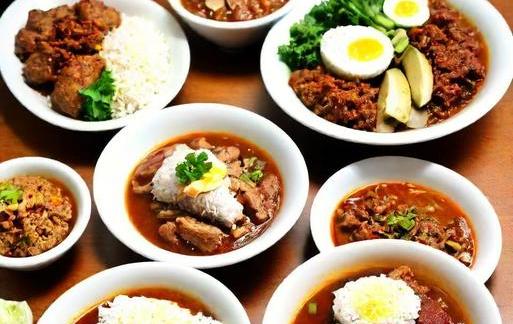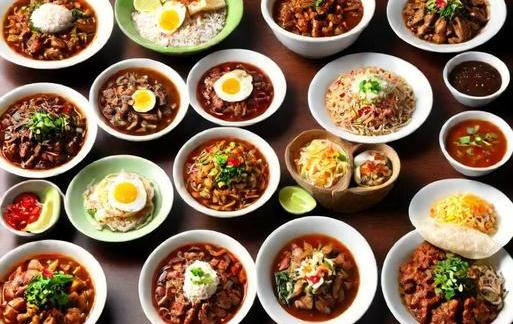- You are here:
- Home »
- Food
- » [REVEALED] Filipino Foods That Start With E
[REVEALED] Filipino Foods That Start With E
Note: This page contains affiliate links.
As an Amazon Associate, I earn from qualifying purchases when you click on the link, but you are not charged extra.
Filipino cuisine is a rich tapestry of flavors, reflecting the country’s diverse cultural influences and abundant natural resources. From savory to sweet, Filipino dishes never fail to tantalize the taste buds. In this culinary exploration, we delve into the world of Filipino foods that start with the letter E. The Philippines, known for its vibrant street food, hearty stews, and sweet delicacies, has several delectable offerings that begin with this letter. Join us on a gastronomic journey through the "E" section of Filipino cuisine.
Contents
List Of Filipino Foods That Start With E

1. Embutido
Description:
Embutido is a Filipino-style meatloaf that is a staple during festive occasions. It typically consists of ground meat, often a combination of pork and beef, mixed with breadcrumbs, raisins, chopped vegetables, and various seasonings. The mixture is shaped into a log, wrapped in foil or banana leaves, and then steamed or baked until fully cooked. Once sliced, the embutido reveals a colorful mosaic of ingredients, providing a burst of flavors in every bite.
How It’s Enjoyed:
Embutido is often served sliced, either cold or slightly heated, and is commonly paired with a sweet and tangy tomato-based sauce. It is a favorite during Christmas and other special celebrations, making it a dish that brings families together.
2. Eggplant Salad (Ensaladang Talong)
Description:
Ensaladang Talong is a refreshing and healthy Filipino salad made from grilled or roasted eggplants. The eggplants are charred over an open flame, giving them a smoky flavor, and then peeled to reveal the tender flesh. The eggplant is typically cut into bite-sized pieces and mixed with tomatoes, onions, and sometimes salted duck eggs. A drizzle of fish sauce or bagoong (shrimp paste) adds a savory kick, creating a delightful medley of flavors and textures.
How It’s Enjoyed:
Ensaladang Talong is commonly enjoyed as a side dish or appetizer. It pairs well with grilled or fried meats and is often accompanied by rice. The combination of smokiness from the eggplant and the savory dressing makes it a simple yet satisfying dish.
3. Escabeche
Description:
Escabeche is a Filipino sweet and sour dish that typically features fried fish or meat, usually tilapia or lapu-lapu (grouper). The protein is coated with flour, deep-fried until crispy, and then smothered in a sweet and tangy sauce made from vinegar, sugar, and soy sauce. Vegetables like bell peppers, carrots, and onions are added to the mix, enhancing both the flavor and visual appeal of the dish.
How It’s Enjoyed:
Escabeche is often served as a main course, especially during celebrations and family gatherings. The crispy texture of the fried fish or meat, combined with the vibrant and flavorful sauce, makes it a favorite among Filipinos.
4. Egg Pie
Description:
Egg pie is a popular Filipino dessert that boasts a smooth and creamy custard filling nestled in a flaky pie crust. The custard is made with a combination of eggs, condensed milk, and evaporated milk, creating a luscious and sweet filling. The pie is baked until the custard sets and the crust turns golden brown, resulting in a delightful treat with a perfect balance of sweetness and richness.
How It’s Enjoyed:
Egg pie is often served chilled, making it a refreshing dessert for warm days. It is a common sight in local bakeries and is frequently enjoyed as a snack or dessert after meals.
5. Etag
Description:
Etag is a traditional smoked meat in Filipino cuisine, particularly among the Igorot people in the northern part of the Philippines. It is made by curing and smoking pork or beef in the mountainous regions, using traditional methods that have been passed down through generations. The meat is seasoned with salt and other local spices before being air-dried and smoked. The result is a flavorful and preserved meat that can be stored for an extended period.
How It’s Enjoyed:
Etag is a versatile ingredient used in various dishes, adding a distinct smoky flavor to stews, vegetables, and rice. It is often enjoyed as a condiment or a flavorful addition to enhance the taste of other dishes.
6. Espasol
Description:
Espasol is a traditional Filipino sweet delicacy hailing from the province of Laguna. It is a cylindrical rice cake made from glutinous rice flour, coconut milk, and sugar. The mixture is cooked until it thickens and is then molded into its characteristic shape. The outer layer is coated with toasted rice flour, giving it a slightly gritty texture, while the inside remains soft and chewy. Espasol is often wrapped in colorful cellophane, adding a festive touch to this sweet treat.
How It’s Enjoyed:
Espasol is a popular snack or dessert during fiestas and special occasions. It is often served in slices and enjoyed with a cup of hot coffee or tea. The combination of the nutty rice flour coating and the sweet, chewy interior makes it a delightful and comforting treat.
7. Egg Drop Soup (Sopas)
Description:
While the term "Egg Drop Soup" may sound more Chinese than Filipino, the Filipino version, known as Sopas, has its unique twist. Sopas is a creamy and hearty chicken soup made with macaroni noodles, diced vegetables, and chunks of chicken. The addition of beaten eggs creates silky ribbons throughout the soup, adding a comforting texture to this Filipino classic.
How It’s Enjoyed:
Sopas is a popular comfort food, especially during rainy days or when someone is feeling under the weather. It is often served for merienda (afternoon snack) or as a light meal, providing warmth and nourishment.
8. Eggplant Adobo (Adobong Talong)
Description:
Adobong Talong is a vegetarian twist on the classic Filipino adobo, replacing meat with eggplants. The eggplants are typically grilled or roasted, then simmered in a savory sauce made from soy sauce, vinegar, garlic, and bay leaves. The result is a flavorful and slightly smoky dish that showcases the versatility of eggplants in Filipino cuisine.
How It’s Enjoyed:
Adobong Talong is commonly served as a side dish or a vegetarian option during meals. It pairs well with steamed rice and other Filipino viands, providing a balance of flavors and textures.
9. Egg Tarts (Egg Pie Tarts)
Description:
Egg tarts, also known as egg pie tarts, are miniature versions of the beloved egg pie. These bite-sized treats consist of a buttery and flaky pastry crust filled with a sweet and velvety egg custard. The filling is often enhanced with a hint of vanilla or lemon zest, adding layers of flavor to each small tart.
How It’s Enjoyed:
Egg tarts are popular as snacks or desserts and are commonly found in bakeries and pastry shops across the Philippines. Their small size makes them perfect for sharing or enjoying individually, providing a delightful burst of sweetness in every bite.
10. Eggplant Omelet (Tortang Talong)
Description:
Tortang Talong is a Filipino eggplant omelet that transforms simple ingredients into a flavorful and satisfying dish. Grilled or roasted eggplants are flattened and then coated in beaten eggs before being pan-fried to perfection. The result is a hearty omelet with layers of smoky eggplant and fluffy eggs, creating a harmonious blend of flavors and textures.
How It’s Enjoyed:
Tortang Talong is often served as a breakfast or lunch dish, accompanied by rice and a side of sliced tomatoes or a vinegar dipping sauce. It is a popular home-cooked meal, cherished for its simplicity and deliciousness.
The Filipino foods that start with the letter E showcase the diversity and creativity of the country’s culinary landscape. From savory delights like Embutido and Escabeche to sweet treats like Egg Pie and Espasol, each dish tells a story of tradition, innovation, and the Filipino love for good food. Whether enjoyed during festive occasions or as everyday comfort fare, these "E" dishes contribute to the rich tapestry that is Filipino cuisine. As we conclude this gastronomic journey, we invite you to explore, savor, and appreciate the unique flavors and textures that make Filipino foods a true culinary delight.
Significance

Filipino cuisine is a rich tapestry of flavors, blending indigenous ingredients with influences from Spanish, Chinese, and Malay cultures. The diverse culinary landscape of the Philippines showcases an array of dishes that cater to various tastes and preferences.
Understanding the significance of Filipino foods that start with ‘E’ requires delving into the cultural, historical, and geographical aspects that shape the nation’s culinary identity. The Philippines’ archipelagic geography, coupled with its history of colonization, has resulted in a unique blend of ingredients and cooking techniques. The significance of these ‘E’ dishes lies not only in their taste but also in the stories they tell about Filipino heritage.
Category-Related

**1. ** Embutido
Embutido, a beloved Filipino meatloaf, takes center stage in the ‘E’ category. This dish, reminiscent of the Spanish embutido, showcases the fusion of culinary influences. A flavorful mix of ground pork, minced ham, raisins, and various spices, it is wrapped in foil and steamed or baked until perfection. Served during festive occasions, embutido encapsulates the essence of Filipino celebrations.
**2. ** Ensaladang Talong
A refreshing addition to Filipino cuisine, ensaladang talong is an eggplant salad that tantalizes the taste buds with its combination of grilled eggplants, tomatoes, onions, and bagoong (fermented shrimp paste). This ‘E’ dish highlights the Filipino love for incorporating grilled elements into their meals, creating a delightful medley of flavors and textures.
**3. ** Egg Pie
Satisfying sweet cravings, egg pie emerges as a delectable dessert. Combining simplicity with indulgence, this Filipino custard pie features a velvety filling made from eggs, condensed milk, and vanilla, housed in a flaky pie crust. Egg pie resonates with Filipino families, often enjoyed during gatherings and special occasions.
**4. ** Eggplant Adobo
A vegetarian twist on the classic Filipino adobo, eggplant adobo offers a flavorful alternative. Sliced eggplants soak up the savory adobo sauce, creating a dish that showcases the adaptability of traditional Filipino flavors. This ‘E’ dish not only caters to vegetarians but also adds a unique dimension to the diverse Filipino adobo repertoire.
Common Themes
1. Fusion Of Influences
Filipino cuisine is renowned for its ability to seamlessly blend diverse influences. The ‘E’ dishes discussed here exemplify this fusion – from the Spanish-inspired embutido to the grilled goodness of ensaladang talong. These dishes embody the syncretism that defines Filipino cooking, showcasing how various cultural influences have contributed to the country’s culinary tapestry.
2. Celebration Of Fresh Ingredients
A common theme among Filipino foods that start with ‘E’ is the celebration of fresh, local ingredients. Whether it’s the succulent pork in embutido or the vibrant vegetables in ensaladang talong, these dishes emphasize the importance of using high-quality, locally-sourced produce. This connection to the land and its offerings is a hallmark of Filipino culinary philosophy.
3. Sweet Endings
The inclusion of egg pie in this list highlights another common theme in Filipino cuisine – a love for sweet endings. Desserts play a significant role in Filipino celebrations, and egg pie with its rich custard filling encapsulates the indulgent, comforting sweetness that concludes many Filipino meals.
4. Adaptability And Creativity
The ‘E’ dishes showcase the adaptability and creativity inherent in Filipino cooking. Eggplant adobo is a prime example, demonstrating how traditional recipes can be reimagined to cater to different dietary preferences. This adaptability reflects the resourcefulness of Filipino cooks, who are adept at using local ingredients to create innovative and delicious dishes.
Interesting Facts
1. Historical Roots Of Embutido
Embutido traces its roots back to the Spanish embutido, brought to the Philippines during the colonial era. Over the years, Filipinos have infused the dish with local flavors, making it uniquely their own. The evolution of embutido reflects the dynamic nature of Filipino cuisine, where foreign influences are embraced and transformed into something distinctly Filipino.
2. Egg Pie Variations
While egg pie is a popular dessert, regional variations exist, showcasing the diverse culinary practices across the Philippines. Some regions add a twist by incorporating local fruits or infusing the custard with unique flavors, offering a delightful range of egg pie experiences.
3. Ensaladang Talong Traditions
Ensaladang talong has regional variations that highlight the diversity of Filipino cooking. In some areas, it is served with a side of bagnet (crispy fried pork belly), providing a savory contrast to the grilled eggplant. This illustrates how a simple salad can be adapted to suit local tastes and complement other regional dishes.
4. Eggplant Adobo And Vegetarianism
The emergence of eggplant adobo reflects a growing trend towards vegetarianism in the Philippines. As more people adopt plant-based diets, Filipino cooks are finding inventive ways to create meatless versions of traditional dishes. Eggplant adobo serves as a testament to the adaptability of Filipino cuisine in response to changing dietary preferences.
Conclusion
In conclusion, Filipino foods that start with ‘E’ offer a captivating journey through the diverse and flavorful world of Filipino cuisine. From the historical influences seen in embutido to the creative adaptations of eggplant adobo, these dishes reflect the richness of Filipino culinary traditions. The common themes of fusion, celebration of fresh ingredients, sweet endings, and adaptability weave a narrative that resonates with the cultural and geographical tapestry of the Philippines.
Exploring these ‘E’ dishes not only provides a sensory experience but also unveils the stories embedded in each bite. As Filipino cuisine continues to evolve, embracing both tradition and innovation, these dishes stand as a testament to the resilience and creativity of Filipino cooks. Whether enjoyed during festive celebrations or as everyday comfort food, Filipino foods that start with ‘E’ are a testament to the nation’s vibrant culinary heritage.


